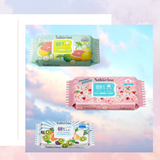How to Clean Your Makeup Sponge
Posted on June 04 2020

Makeup sponges may seem like a self-explanatory tool, but they’re not. I understood that when my first few sponges ended up covered in stains or moldy. It’s a common mistake, it seems. There was even a fad two or three years ago where makeup bloggers and YouTubers cut open their sponges to find pools of curdled foundation, mildew, and sometimes even insects inside. No one wants to squish any of that into their face (especially if you have acne-prone skin), so let’s review what we need to do to keep those sponges clean.
The Products
I will be following my own advice in this tutorial, so you can see how well it works. My sponges are a hexagonal Burt’s Bees sponge (it comes with their Mattifying Powder Foundation) and a beauty sponge I bought at Seria, a Japanese 100 yen shop. Essentially, that’s like a slightly nicer dollar store, so I assume the brand of sponge isn’t important. I don’t remember it, anyway.
About the solid soap, the Beautyblender Sponge and Brush Cleansers are highly effective, but I found my Basis Sensitive Skin Bar pretty effective, too.
Many people use baby shampoo or oil-based cleansers for liquid soap, but here I have used my dishwashing soap, Seventh Generation. I am not paid by any of these companies.
Using and Maintaining Your Sponge
1. Get it damp before using it to apply makeup
Makeup sponges based on the original Beautyblender are meant to blend the best when wet and fully expanded. The surface of the sponge will be less porous and therefore smoother, and because the sponge has already absorbed water, it will absorb less of your makeup. Be sure to wring out excess water, though.
2. After you’re finished applying makeup, get it completely wet again
Put the sponge under warm water until it has fully expanded. We want water all throughout the sponge. Wait for the sponge to fully expand to its full size so the water and soap can get into every crevice.
3. Wash it with bar soap
Wet the bar soap with warm water and rub it until it lathers. The lather is the key to the soap being able to permeate the sponge.
Rub every inch of the sponge against the bar soap under running water. Make sure to scrunch the sponge intermittently to really get the soap into the core of the sponge. When there’s no more makeup coming out of the sponge, you’re almost done!
4. Rinse it and make sure all soap is gone
This step is pretty self-explanatory. You don’t want soap rubbed into your skin and caked over with primer and foundation—it’ll break out your skin.

The hourglass sponge The hexagonal sponge
5. Keep it in a stand—never store it damp
Storing a damp sponge in a non-breathable container (like a Ziploc bag) in a dark environment is just asking for mold. I use a stand to allow air to flow freely around the sponge and dry it completely. This stand is also from Seria and I no longer remember the brand, but there are plenty more stands and pods to be found.
6. Get a new one after 3-6 months of use
Obviously, you should wash your sponge after every use, but can you use it indefinitely? Beautyblender advises you to replace your sponge after 3 to 6 months of use, depending on how well and regularly you clean it. The deciding factor in their advice seems to be whether the sponge has nicks, tears, or deformities in it, which can interfere in the application of makeup. Also, if you’re suddenly breaking out and you can’t connect it to a change in skincare, makeup, diet, medicine, or if you aren’t on your period, it may be because your makeup sponge is inundated with old makeup. Granted, it could also mean your phone, earrings, or earbuds need to be cleaned as well. Might as well clean everything, right? It’s almost summer, so spring cleaning time is running out!
Deep-Cleaning the Sponge
1. Soak it in soapy water for 30 minutes
Here’s where liquid soap becomes useful. Make sure the water is nice and lathered up before you drop the sponges in.


2. Rinse the sponges of soap, and move them into clean water
Since we’re going to nuke the sponges, we don’t want the water to be hot soap soup. The thicker sponges can hold a lot of soap in them, so wring them out several times. It’s important that the sponge is moist, or it will catch fire in the microwave.
More makeup has seeped out after thirty minutes. Clean water is needed.
3. Microwave it while still in the water
Microwave the sponges and the water for one minute in a microwavable bowl. This study by Saint Martin University’s Biology Journal found that microwaving kitchen sponges for one minute reduced bacteria cultures inside kitchen sponges, though it wasn’t statistically significant. Technically, the most effective methods were boiling for 10 minutes, dishwashing, and washing in a washing machine. These were, however, kitchen sponges, which are much tougher than makeup sponges, and the microwaved sponges were not washed with soap nor rinsed. You can throw your sponge in the washing machine if it’s cheap enough, but I wouldn’t risk it.
4. Rinse it out well
Like I said before, these bad boys can hold a lot of soap, and we don’t want to rub that in our faces, either.
5. Repeat, or wash with bar soap until free of stains
Unfortunately, my makeup sponge still has 「とん」written on it in liquid eyeliner (I didn’t do that on purpose), and there’s still a spot on the hexagonal sponge. To be fair, though, I left them for months without properly cleaning them, and I am pretty sure I’ve killed whatever bacteria were living in there.

Use your makeup sponge free from worry!
Having healthy skin isn’t all about diet and skincare! Sometimes, a breakout or other skin infection simply comes down to something dirty touching your face. Be it your hair, a hat, jewelry, your sheets, or a makeup sponge, it’s always a good idea to make sure the things that touch your skin are squeaky clean!
To find out more, visit our websites and explore our Blog more!

Lauren Goff
Lauren is a writer who spent two years teaching English in Japan and is curious about skincare products. Though she lives in America now, she is still in love with Tohoku. Her short stories and essays can be found in The Vortex Magazine of Literature and Art and Cirsova.












